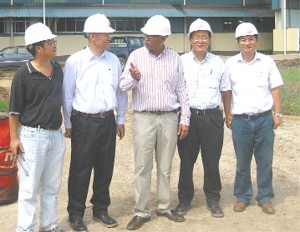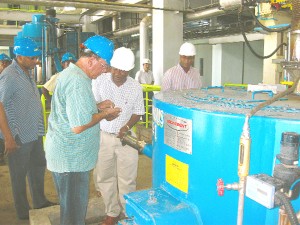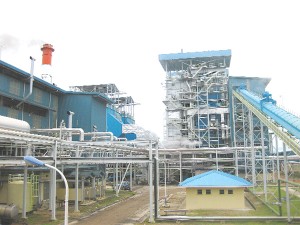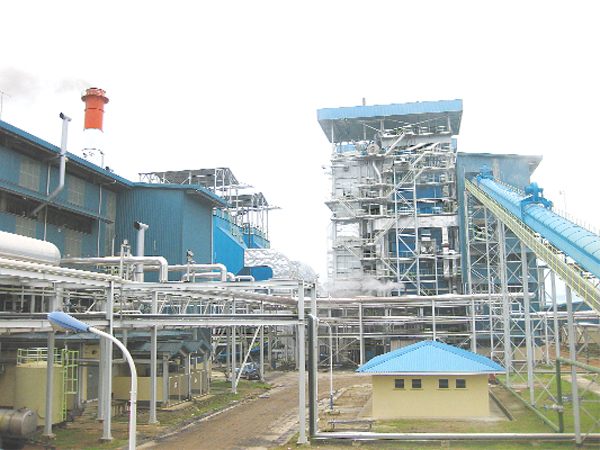-testing to continue
After experiencing hurdles with the start up and interruptions from poor conditions, the new Skeldon Sugar Factory has produced “several hundred tonnes” of sugar and finally started grinding on a continuous basis from 4 am on Tuesday.

During a tour of the factory yesterday, Minister of Agriculture, Robert Persaud told the media that the testing which started on March 6 would continue for the entire crop and would be monitored closely.
He said too that the old factory has already been put out of use and the new US$181M factory would be producing the Skeldon quota of sugar.
The minister said that the results received from the technical managers have been encouraging compared to the previous test in early September. The factory has so far crushed close to 16,000 tonnes of cane amounting to “several hundred tonnes of sugar in the bins” which are of export quality.

Site representative from the contracting company; China National Technology Import and Export Corporation (CNTIC), Andrew Jin had said that the factory had originally experienced technical difficulties during the second part of the commissioning exercise, involving a 72-hour test run.
These involved problems of the interface between the punt dumper and the conveyor belt and problems with the shredder bearings among other technical difficulties.

He had said too that the contracting company was conducting assessments and remedial work and was working collaboratively with the engineers and employers to move the project to the next stage of the commissioning.
Jin had pointed out that major construction was completed in May and the commissioning began on August 26 with three dry runs. From September 9 to 11 the factory crushed a total of 2,000 tonnes of sugar cane when it ran into technical difficulties.
He told this newspaper yesterday that the defects were identified by Guysuco and had been rectified during the out-of-crop season.
He said rain was one of the major setbacks for the testing as the cane-harvesters could not have been used and there was a limited supply of cane. Initial problems also existed with the X001 cane conveyor which had a tracking problem and had to be adjusted.
Meanwhile he said the factory has a chemical water treatment plant but the capacity is not enough for the boilers and that Guysuco is currently using a tractor to deliver more water. He noted too that there has been better coordination between Guysuco and the contractors.
The factory was supposed to have been in commercial production from the second crop last year but missed that deadline and also the start of this crop. Liquidated damages were then applied in this turn-key project.
Power generation
The minister stated that power is being generated from the bagasse and that eight megawatts (mw) of electricity is being produced per hour, amounting to 192 mw per day. He said the bagasse is important in bringing down cost and has helped to obviate the use of fossil fuel while realizing the full efficiency of the facility.
Price
He said the factory is aimed at withstanding the European Commission price cut and being a “global player” in terms of selling sugar. The ultimate capacity of the mill would be 110,000 tonnes of sugar per annum, processing 1.1 million tonnes of cane.
Persaud pointed out that he is quite confident that the Chinese contractors would be able to overcome the difficulties that they had and would be able to present to Guysuco a working factory in the near future.
Not enough cane
He pointed to the challenge faced in relation to cane production and said the chairman and the new management have placed emphasis on private cane farmers expanding. The minister admitted that a lot of cane is needed to supply the “massive factory” and said right now the aim is to get up to 200 tonnes per hour and then ultimately to the full capacity of 350 tonnes.
He said the private farmers are much more encouraging as they have gotten through with financing from the bank. “I am quite sure that when they look up and see the steam and that the factory is running it would motivate them.”
However, he said if the private farmers do not come on board “as full as they should we are looking at other options which we wouldn’t speak about now.”
They have to deliver 35 to 40% of the cane to the factory and the administration has worked with them very closely and “so far has no reason to question their commitment to the project.” According to him, the plan is to have the full supply of cane over a period of two and a half to three years.
Drainage
Minister Persaud pointed out that the drainage has to be expanded and central government would be assisting in this area. He said four drainage structures have been brought to Molsen Creek and government has to mobilize the resources for the fifth one.
Guysuco has to make modifications to the drainage and the National Drainage & Irrigation Authority “would see if it can expedite the drainage requirement.” He noted that there has been some slippage in terms of Guysuco’s drainage to expand the cultivation at Skeldon and that correction works have started.
Market
Asked about markets, Persaud said that is not an issue but it is their ability to supply the market. He is confident that they would accomplish that with the production.
However he is concerned about the price that would be paid for the sugar and whether it would be profitable. He said that from October 1 the EU Sugar Protocol would no longer exist so revenue of close to $7B would be lost per annum.
To counter that, sugar would have to be produced at a competitive price and all inefficiencies would have to be dealt with, he said.
“Part of the blueprint that the board and the management are working on is to look at cost reduction and dealing with those variables that would eventually make the industry more viable,” Persaud told the media.
He said once the price cut takes full effect the industry would have a period of transformation and transition to move from a preferential price to compete with a price that the world offers.
He noted that the transition period would require some elements of hardship, greater commitment and stronger and much more effective management of Guysuco.
Also accompanying the minister was shadow Agriculture Minister for the People’s National Congress Reform-One Guyana, Anthony Vieira, officials of CNTIC and Guysuco including Yusuff Abdul; General Manager of Technical Services.
Vieira who is also on the parliamentary Economic Services Committee, told the media that he was “happy to see a brand new factory” but was not optimistic that the factory would attract the amount of cane that is needed for production.

